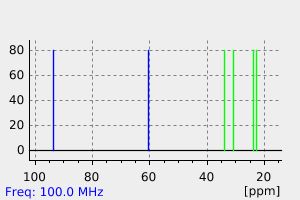trans-1-chloro-2-fluorocyclohexane | 20421-40-3
中文名称
——
中文别名
——
英文名称
trans-1-chloro-2-fluorocyclohexane
英文别名
(1R,2R)-1-chloro-2-fluorocyclohexane
CAS
20421-40-3
化学式
C6H10ClF
mdl
——
分子量
136.597
InChiKey
RGXZXBASNKTHQI-PHDIDXHHSA-N
BEILSTEIN
——
EINECS
——
-
物化性质
-
计算性质
-
ADMET
-
安全信息
-
SDS
-
制备方法与用途
-
上下游信息
-
文献信息
-
表征谱图
-
同类化合物
-
相关功能分类
-
相关结构分类
物化性质
-
沸点:157.5±23.0 °C(Predicted)
-
密度:1.07±0.1 g/cm3(Predicted)
计算性质
-
辛醇/水分配系数(LogP):2.5
-
重原子数:8
-
可旋转键数:0
-
环数:1.0
-
sp3杂化的碳原子比例:1.0
-
拓扑面积:0
-
氢给体数:0
-
氢受体数:1
反应信息
-
作为产物:参考文献:名称:Triethylamine Tris-hydrofluoride [(C2H5)3N·3HF]: A Highly Versatile Source of Fluoride Ion for the Halofluorination of Alkenes摘要:N-卤代苏胺/三乙胺三氟化物的组合被提出作为一种方便的试剂,用于烯烃的卤氟化反应。DOI:10.1055/s-1987-28004
文献信息
-
Selective Halofluorination of Alkenes with Tetrabutylphosphonium Dihydrogentrifluoride in Combination with<i>N</i>-Halosuccinimide or 1,3-Dibromo-5,5-dimethylhydantoin作者:Yukitaka Uchibori、Masayuki Umeno、Hideharu Seto、Hirosuke YoshiokaDOI:10.1246/cl.1993.673日期:1993.4Alkenes and their functionalized derivatives were readily converted to the corresponding halofluorides with tetrabutylphosphonium dihydrogentrifluoride as combined with N-halosuccinimides or 1,3-dibromo-5,5-dimethylhydantoin in highly regio-, stereo-, and chemoselective manners. In particular, alkenes having a oxirane or primary hydroxyl group also underwent halofluorination selectively in good yields
-
Mass spectra of dihalogenocycloalkanes作者:D. S. Ashton、J. M. Tedder、J. C. WaltonDOI:10.1039/j29700001775日期:——The mass spectra of the dichloro- and bromochloro-cyclobutanes, the dichlorocyclopentanes, and the dichloro-, chlorofluoro-, and stable dibromo-cyclohexanes are reported. Four major breakdown pathways can be distinguished, the favoured fragmentation route depending on the ring size, the type of halogen substitution, the the relative position, and cis–trans-relationships of the two substituents. Within
-
Boron trifluoride promoted reactions of n-haloelectrophiles with alkenes作者:Gene E. Heasley、J. Mark Janes、Stephen R. Stark、Brian L. Robinson、Victor L. Heasley、Dale F. ShellhamerDOI:10.1016/s0040-4039(00)94744-0日期:1985.1N-Haloelectrophiles react with alkenes in the presence of boron rifluoride etherate to give halofluorides and N-halo adducts.
-
Reaction of alkylhypochlorites and xenon difluoride with cyclohexene作者:Dale F. Shellhamer、Mark J. Horney、Andrew L. Toth、Victor L. HeasleyDOI:10.1016/s0040-4039(00)60891-2日期:1992.11Reactions of alkylhypochlorites and xenon difluoride with cyclohexene give primarily 1-chloro-2-fluorocyclohexanes via formation of a complex between xenon difluoride and the alkylhypochlorite.
-
Efficient utilization of tetrabutylammonium bifluoride in halofluorination reactions作者:F. Camps、E. Chamorro、V. Gasol、A. GuerreroDOI:10.1021/jo00279a013日期:1989.9
表征谱图
-
氢谱1HNMR
-
质谱MS
-
碳谱13CNMR
-
红外IR
-
拉曼Raman
-
峰位数据
-
峰位匹配
-
表征信息
同类化合物
顺式-2-氯环己基高氯酸盐
顺式-1-溴-2-氟-环己烷
顺式-1-叔丁基-4-氯环己烷
顺式-1,2-二氯环己烷
顺-1H,4H-十二氟环庚烷
镓,三(三氟甲基)-
镁二(1,1,2,2,3,3,4,4,5,5,6,6,7,7,8,8,8-十七氟-1-辛烷磺酸酯)
铵2,2,3,3,4,4,5,5,6,6,7,7,8,8,9,9,10,10,11,11,12,12,12-二十三氟十二烷酸盐
铜N-(2-氨基乙基)乙烷-1,2-二胺2-氰基胍二氯化盐酸
钾{[(十七氟辛基)磺酰基](甲基)氨基}乙酸酯
钠3-[(3-{[(十七氟辛基)磺酰基]氨基}丙基)(甲基)氨基]-1-丙烷磺酸酯
重氮基烯,(1-溴环己基)(1,1-二甲基乙基)-,1-氧化
辛酸,十五氟-,2-(1-羰基辛基)酰肼
赖氨酰-精氨酰-精氨酰-苯基丙氨酰-赖氨酰-赖氨酸
诱蝇羧酯B1
诱蝇羧酯
萘并[2,1-b]噻吩-1(2H)-酮
膦基硫杂酰胺,P,P-二(三氟甲基)-
脲,N-(4,5-二甲基-4H-吡唑-3-基)-
肼,(3-环戊基丙基)-,盐酸(1:1)
组织蛋白酶R
磷亚胺三氯化,(三氯甲基)-
碳标记全氟辛酸
碘甲烷与1-氮杂双环(4.2.0)辛烷高聚合物的化合物
碘甲烷-d2
碘甲烷-d1
碘甲烷-13C,d3
碘甲烷
碘环己烷
碘仿-d
碘仿
碘乙烷-D1
碘[三(三氟甲基)]锗烷
硫氰酸三氯甲基酯
甲烷,三氯氟-,水合物
甲次磺酰胺,N,N-二乙基-1,1,1-三氟-
甲次磺酰氯,氯二[(三氟甲基)硫代]-
甲基碘-12C
甲基溴-D1
甲基十一氟环己烷
甲基丙烯酸正乙基全氟辛烷磺
甲基三(三氟甲基)锗烷
甲基[二(三氟甲基)]磷烷
甲基1-氟环己甲酸酯
环戊-1-烯-1-基全氟丁烷-1-磺酸酯
环己烷甲酸4,4-二氟-1-羟基乙酯
环己烷,1-氟-2-碘-1-甲基-,(1R,2R)-rel-
环己基五氟丙烷酸酯
环己基(1-氟环己基)甲酮
烯丙基十七氟壬酸酯







